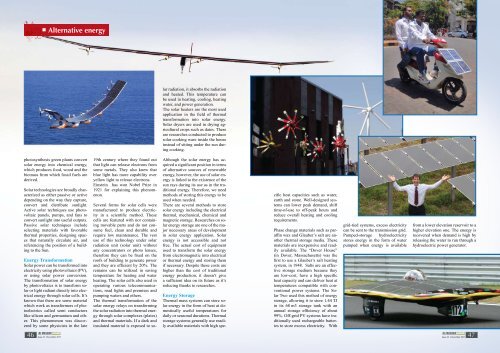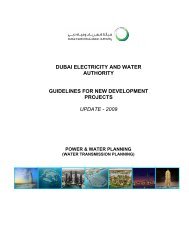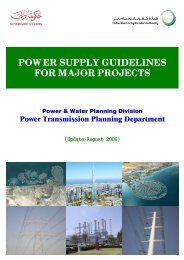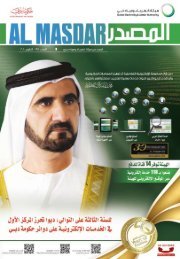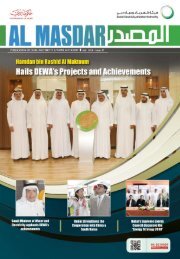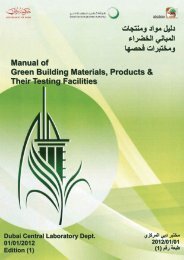Al Masdar Magazine
Al Masdar Magazine
Al Masdar Magazine
Create successful ePaper yourself
Turn your PDF publications into a flip-book with our unique Google optimized e-Paper software.
<strong>Al</strong>ternative energy<br />
photosynthesis green plants convert<br />
solar energy into chemical energy,<br />
which produces food, wood and the<br />
biomass from which fossil fuels are<br />
derived.<br />
Solar technologies are broadly characterized<br />
as either passive or active<br />
depending on the way they capture,<br />
convert and distribute sunlight.<br />
Active solar techniques use photovoltaic<br />
panels, pumps, and fans to<br />
convert sunlight into useful outputs.<br />
Passive solar techniques include<br />
selecting materials with favorable<br />
thermal properties, designing spaces<br />
that naturally circulate air, and<br />
referencing the position of a building<br />
to the Sun.<br />
Energy Transformation<br />
Solar power can be transformed into<br />
electricity using photovoltaics (PV),<br />
or using solar power conversion.<br />
The transformation of solar energy<br />
by photovoltaics is to transform solar<br />
or light radiant directly into electrical<br />
energy through solar cells. It’s<br />
known that there are some material<br />
which work as transformers of photoelectrics<br />
called semi conductors<br />
like silicon and germanium and other.<br />
This phenomenon was discovered<br />
by some physicists in the late<br />
19th century where they found out<br />
that light can release electrons from<br />
some metals. They also knew that<br />
blue light has more capability over<br />
yellow light to release electrons.<br />
Einstein has won Nobel Prize in<br />
1921 for explaining this phenomenon.<br />
Several forms for solar cells were<br />
manufactured to produce electricity<br />
in a scientific method. These<br />
cells are featured with not containing<br />
movable parts and do not consume<br />
fuel, clean and durable and<br />
require low maintenance. The vest<br />
use of this technology under solar<br />
radiation unit (solar unit) without<br />
any concentrators or photo lenses,<br />
therefore they can be fixed on the<br />
roofs of building to generate power<br />
and they are efficient by 20%. The<br />
remains can be utilized in saving<br />
temperature for heating and water<br />
heating. The solar cells also used in<br />
operating various telecommunications,<br />
road lights and premises and<br />
pumping waters and others.<br />
The thermal transformation of the<br />
solar energy relays on transforming<br />
the solar radiation into thermal energy<br />
through solar complexes (plates)<br />
and thermal materials. If a dark and<br />
insulated material is exposed to solar<br />
radiation, it absorbs the radiation<br />
and heated. This temperature can<br />
be used in heating, cooling, heating<br />
water, and power generation.<br />
The solar heaters are the most used<br />
application in the field of thermal<br />
transformation into solar energy.<br />
Solar dryers are used in drying agricultural<br />
crops such as dates. There<br />
are researches conducted to produce<br />
solar cooking ware inside the house<br />
instead of sitting under the sun during<br />
cooking.<br />
<strong>Al</strong>though the solar energy has acquired<br />
a significant position in terms<br />
of alternative sources of renewable<br />
energy, however, the use of solar energy<br />
is linked to the existence of the<br />
sun rays during its use as in the traditional<br />
energy. Therefore, we need<br />
methods of storing this energy to be<br />
used when needed.<br />
There are several methods to store<br />
solar energy including the electrical<br />
thermal, mechanical, chemical and<br />
magnetic storage. Researches on solar<br />
energy storage are one of the major<br />
necessary areas of development<br />
in solar energy application. Solar<br />
energy is not accessible and not<br />
free. The actual cost of equipment<br />
used to transform the solar energy<br />
from electromagnetic into electrical<br />
or thermal energy and storing them<br />
if necessary. Despite these costs are<br />
higher than the cost of traditional<br />
energy production, it doesn’t give<br />
a sufficient idea on its future as it’s<br />
reducing thanks to researches.<br />
Energy Storage<br />
Thermal mass systems can store solar<br />
energy in the form of heat at domestically<br />
useful temperatures for<br />
daily or seasonal durations. Thermal<br />
storage systems generally use readily<br />
available materials with high specific<br />
heat capacities such as water,<br />
earth and stone. Well-designed systems<br />
can lower peak demand, shift<br />
time-of-use to off-peak hours and<br />
reduce overall heating and cooling<br />
requirements.<br />
Phase change materials such as paraffin<br />
wax and Glauber’s salt are another<br />
thermal storage media. These<br />
materials are inexpensive and readily<br />
available. The “Dover House”<br />
(in Dover, Massachusetts) was the<br />
first to use a Glauber’s salt heating<br />
system, in 1948. Salts are an effective<br />
storage medium because they<br />
are low-cost, have a high specific<br />
heat capacity and can deliver heat at<br />
temperatures compatible with conventional<br />
power systems. The Solar<br />
Two used this method of energy<br />
storage, allowing it to store 1.44 TJ<br />
in its 68 m3 storage tank with an<br />
annual storage efficiency of about<br />
99%. Off-grid PV systems have traditionally<br />
used rechargeable batteries<br />
to store excess electricity. With<br />
grid-tied systems, excess electricity<br />
can be sent to the transmission grid.<br />
Pumped-storage hydroelectricity<br />
stores energy in the form of water<br />
pumped when energy is available<br />
from a lower elevation reservoir to a<br />
higher elevation one. The energy is<br />
recovered when demand is high by<br />
releasing the water to run through a<br />
hydroelectric power generator.<br />
46 Issue 42 - December 2011 47<br />
Issue 42 - December 2011


